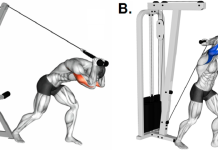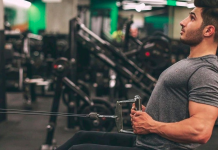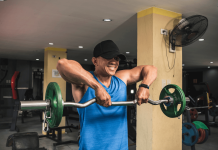Develop a Powerful Lower Chest with Cable Fly Exercises!
A well-developed chest is a symbol of strength and aesthetics in the fitness world. While the upper chest often receives more attention, neglecting the lower chest can lead to an imbalanced physique. To achieve a sculpted and powerful chest, it’s crucial to incorporate targeted exercises, such as the lower chest cable fly, into your workout routine. In this comprehensive guide, we’ll explore the anatomy of the lower chest, the proper form and technique for cable fly exercises, and the advantages of targeting this specific muscle group. Get ready to take your chest training to new heights!
Anatomy of the Lower Chest:
Before we dive into the world of lower chest cable flying, let’s understand the muscles involved and their role in upper body strength. The lower chest primarily consists of the pectoralis major muscle, which is divided into two portions: the clavicular head (upper chest) and the sternal head (lower chest). While many chest exercises like bench presses engage both heads, the lower chest cable flies specifically targets the sternal head, promoting better lower chest development.
The sternal head of the pectoralis major originates from the sternum and inserts into the upper arm bone (humerus). When effectively targeted through cable fly exercises, this muscle group adds depth and fullness to the lower chest, creating a well-rounded and aesthetically pleasing chest appearance.
Proper Form and Technique:
To make the most out of your lower chest cable fly exercises, mastering the correct form and technique is essential. Follow these step-by-step instructions to ensure optimal muscle engagement and reduce the risk of injury:
- Adjust the Cable Pulleys: Set the cable pulleys to the lowest position on both sides of the cable machine. Attach single handles to each pulley.
- Starting Position: Stand facing the cable machine, with one foot slightly in front of the other for stability. Hold one handle in each hand with an overhand grip, and position your arms out to the sides, parallel to the ground.
- Concentric Phase: Exhale and bring your hands together in front of your chest, focusing on squeezing the lower chest. Keep a slight bend in your elbows throughout the movement.
- Eccentric Phase: Inhale as you slowly return to the starting position, controlling the resistance. Keep the motion smooth and controlled, maintaining tension on the lower chest.
- Range of Motion: Avoid locking out your elbows or allowing the weights to touch at the center. Maintain tension in the chest muscles throughout the entire set.
Proper form is paramount for targeting the lower chest effectively. Performing the cable fly with precision ensures that the sternal head of the pectoralis major receives the maximum stimulus, leading to significant muscle growth and strength gains in the lower chest.
Lower Chest Cable Fly Variations:
Variation and progression are essential for continuous muscle development and preventing plateaus. Incorporate the following lower chest cable fly variations to challenge your muscles in different ways and promote well-rounded chest growth:
- Decline Cable Fly: Set the cable pulleys at the bottom position of a decline bench. Lie down on the bench and perform the cable fly with the same form as described earlier. The decline angle emphasizes the lower chest muscles even more.
- Single-Arm Cable Fly: Perform the cable fly one arm at a time. This variation helps correct strength imbalances between the left and right sides and allows for a more targeted focus on the lower chest.
- Incline Cable Fly: Set the cable pulleys at the top position of an incline bench. Lie down on the bench and perform the cable fly with the same form as before. The incline angle places additional emphasis on the upper chest while still engaging the lower chest.
By incorporating these variations into your chest training routine, you can stimulate different areas of the chest and achieve a well-proportioned and defined chest that stands out from every angle.
Advantages of Cable Fly for Lower Chest:
Targeting the lower chest with cable fly exercises offers numerous advantages that contribute to a well-rounded and powerful chest development. Let’s explore the benefits of incorporating cable fly into your chest training routine:
- Precise Muscle Isolation: Cable fly exercises allow for precise targeting of the sternal head of the pectoralis major, which is responsible for the lower chest’s development. The constant tension provided by the cable resistance ensures maximum muscle engagement, leading to better muscle hypertrophy and definition.
- Full Range of Motion: Unlike some traditional chest exercises, cable fly provides continuous resistance throughout the entire range of motion. This constant tension ensures that the lower chest muscles are effectively worked from the beginning to the end of each repetition, promoting optimal muscle growth.
- Reduced Stress on Joints: Cable fly exercises impose less stress on the shoulder and elbow joints compared to heavy pressing movements like bench presses. This makes it an excellent choice for individuals with shoulder issues or those looking to minimize joint strain while still effectively targeting the lower chest.
- Balanced Chest Development: Incorporating cable fly into your chest workout routine helps address any imbalances between the upper and lower chest muscles. This balanced development not only improves aesthetics but also enhances overall chest strength and functionality.
- Versatility and Adaptability: Cable machines provide a wide range of motion and adjustable resistance, allowing you to customize your workout to match your fitness level and goals. Whether you’re a beginner or an advanced lifter, cable fly exercises can be adapted to suit your needs.
By harnessing the advantages of cable flying for your lower chest, you can take your chest training to the next level and achieve a well-developed and aesthetically pleasing chest that demands attention.
Designing a Lower Chest Workout Routine:
Integrating the lower chest cable fly into a well-designed workout routine is key to maximizing your chest development. Here’s a sample lower chest workout that focuses on cable fly exercises along with other complementary movements:
Workout Overview:
- Cable Fly (Lower Chest Emphasis): 3 sets x 10-12 reps
- Barbell or Dumbbell Bench Press: 4 sets x 6-8 reps
- Decline Push-Ups: 3 sets x max reps
- Incline Dumbbell Press: 3 sets x 8-10 reps
Rest between sets: 60-90 seconds.
Workout Notes:
- Begin with the cable fly exercise to pre-exhaust the lower chest muscles and enhance their activation during subsequent compound exercises.
- Follow up with a heavy barbell or dumbbell bench press to further engage both the upper and lower chest muscles.
- Decline push-ups are an effective bodyweight exercise that targets the lower chest while engaging the triceps and shoulders.
- Finish the workout with an incline dumbbell press to target the upper chest and maintain a balanced chest development.
Remember to warm up adequately before starting the workout and perform each exercise with proper form and control. Adjust the weight and repetitions based on your fitness level and progressively increase the resistance as you advance.
Combining Lower Chest Cable Fly with Other Exercises:
To achieve a well-rounded and fully developed chest, it’s essential to combine the lower chest cable fly with other chest exercises that target different areas of the chest. By incorporating a variety of movements, you can stimulate muscle growth from various angles and optimize your chest training routine. Here are some complementary exercises to include:
- Incline Cable Press: This exercise targets the upper chest and complements the lower chest cable fly, promoting balanced chest development. Set the cable pulleys at the top position of an incline bench and perform a pressing motion similar to a bench press.
- Dips: Dips are an effective bodyweight exercise that targets both the chest and triceps. For lower chest emphasis, lean slightly forward during the movement to increase the involvement of the lower chest muscles.
- Chest Dumbbell Fly: While the cable fly provides constant tension, the dumbbell fly offers a different challenge by engaging in stabilizing muscles. Lie on a flat bench with a dumbbell in each hand, and perform a fly motion, focusing on the stretch and squeeze of the lower chest.
- Push-Up Variations: Incorporate different push-up variations to target the entire chest area. Wide-grip push-ups and decline push-ups are particularly effective for engaging the lower chest.
By combining these exercises with the lower chest cable fly, you create a comprehensive chest workout that covers all aspects of chest development, leading to a well-proportioned and sculpted chest.
Common FAQs about Lower Chest Cable Fly:
Q: Can I perform cable fly exercises with resistance bands?
A: Yes, resistance bands can be an effective alternative to cable machines for performing cable fly exercises, allowing you to maintain constant tension on the lower chest muscles.
Q: How frequently should I include lower chest cable fly in my workout routine?
A: Aim to perform lower chest cable fly exercises 1-2 times per week, allowing adequate rest and recovery between sessions.
Q: Can women benefit from lower chest cable fly exercises?
A: Absolutely! Lower chest cable fly exercises are beneficial for both men and women, helping to tone and strengthen the chest muscles.
Q: Is the cable fly suitable for beginners?
A: Yes, beginners can perform cable fly exercises. Start with lighter weights and focus on mastering proper form before increasing resistance.
Q: Can I use a cable crossover machine for cable fly exercises?
A: Yes, a cable crossover machine is suitable for cable fly exercises, offering a wide range of motion and adjustability.
Safety and Precautions:
While the lower chest cable fly is an effective exercise, it’s essential to prioritize safety during your workout routine. Here are some safety tips and precautions to keep in mind:
- Warm-up: Always warm up before starting your chest workout to increase blood flow to the muscles and prevent injury.
- Proper Form: Maintain proper form throughout the exercises to prevent strain on the shoulders and lower back.
- Gradual Progression: Gradually increase the weight or resistance used in cable fly exercises to avoid overloading the muscles.
- Mind-Muscle Connection: Focus on the mind-muscle connection during each repetition, ensuring that you are engaging the lower chest effectively.
- Consult a Professional: If you have any existing medical conditions or injuries, consult a fitness professional or healthcare provider before starting a new exercise routine.
By prioritizing safety and incorporating proper technique, you can make the most out of your lower chest cable fly exercises while minimizing the risk of injury.
Progress Tracking and Overcoming Plateaus:
Tracking your progress is vital for monitoring your chest development and ensuring you stay on track with your fitness goals. Here are some effective ways to track your progress and overcome plateaus:
- Keep a Workout Journal: Maintain a workout journal to record your lower chest cable fly exercises’ details, such as sets, reps, and weights used. Tracking your performance over time helps identify trends and areas for improvement.
- Use Performance Metrics: Measure your strength and progress by periodically testing your one-repetition maximum (1RM) or using the Rate of Perceived Exertion (RPE) scale to gauge your effort during workouts.
- Take Progress Photos: Capture photos of your chest from different angles at regular intervals. Comparing these photos over time allows you to visually assess your chest’s development and notice subtle changes.
- Measure Chest Circumference: Use a tape measure to measure your chest circumference regularly. An increase in chest size indicates muscle growth and progress.
- Adjust Variables: When progress slows down, consider adjusting variables such as exercise order, and rep ranges, or using different variations to challenge your muscles differently.
- Implement Periodization: Employ a periodization approach by alternating between phases of high volume and intensity to prevent stagnation and optimize muscle growth.
By tracking your progress and making appropriate adjustments, you can ensure continuous improvement and overcome plateaus on your journey to a well-developed lower chest.
Mastering the lower chest cable fly is a powerful addition to your chest training arsenal. By understanding the anatomy of the lower chest, perfecting your form, and incorporating various exercises, you can achieve a balanced and sculpted chest that commands attention.
Remember, consistency, proper technique, and progressive overload are key to maximizing your chest development. Along with cable fly exercises, integrate other chest movements and follow a well-structured workout routine to target all aspects of chest muscle growth.
As you embark on this fitness journey, pay attention to your body and prioritize safety. Be patient and persistent, as building a strong and aesthetic lower chest takes time and dedication.
Now armed with the knowledge and techniques provided in this guide, it’s time to put them into action and take your chest training to new heights. Embrace the challenge, stay committed, and watch your lower chest transform into a powerful symbol of strength and aesthetics!




